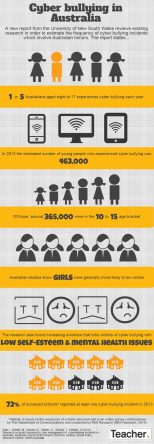Traditional bullying is twice as common as cyber bullying among teenagers, according to a new research analysis of 80 studies from around the world.
Academics say the results show intervention efforts should be aimed at preventing bullying behaviours full stop, instead of focusing on whether they happen online or offline.
The research was led by Dr Kathryn Modecki, from the School of Psychology at Murdoch University, Western Australia and analysed data from more than 300 000 teenagers.
'Youth bully for a range of reasons and we need to treat the underlying issues that propel adolescents to act in harmful ways,' Modecki says.
'Schools and communities have limited resources and we need to be smart about finding ways to have maximum effect on harmful behaviours, wherever they occur.'
Modecki, and colleagues from the United States and Canada, looked at studies measuring both cyber and traditional bullying in adolescents, with involvement as a perpetrator or victim. They found rates of 35 per cent for traditional bullying and 15 per cent for cyber bullying.
'The correlation between the two types of bullying was also relatively high. This means for those youth who do report being bullied online, they [are] likely [to] have also been bullied offline,' Modecki explains. 'Likewise, adolescents who perpetrate or bully online are quite likely to be perpetrators of traditional bullying as well.'
In Bullying Prevalence Across Contexts: A Meta-analysis Measuring Cyber and Traditional Bullying, the researchers say 'policymakers, schools, and parents are hungry for information about where to intervene ...', but getting an accurate measure of the prevalence of bullying is complex and difficult.
'... rates in the literature for cyber perpetration have ranged from 5.3 per cent to 31.5 per cent and those for cyber victimisation have ranged from 2.2 per cent to 56.2 per cent,' the research report says.
'There are also wide differences in rates of traditional bullying among studies comparing prevalence of online and offline behaviour. For instance, rates of traditional bullying perpetration have ranged from 9.68 per cent to 89.6 per cent, and there are similar discrepancies for bullying victimization: 9 per cent to 97.9 per cent'
Part of the problem, the academics argue, is that definitions of what constitutes bullying vary. '... not all researchers endorse the most widely cited characterisation of bullying: harmful and repetitive behaviours enacted by a perpetrator who is more powerful than his or her victim.' They add these definitions are particularly controversial when it comes to cyber bullying.
The results of the two year study have been published online in the Journal of Adolescent Health.
References
Modecki, K. L., Minchin, J., Harbaugh, A. G., Guerra, N. G., & Runions, K. C. (in press). Bullying prevalence across contexts: a meta-analysis measuring cyber and traditional bullying. Journal of Adolescent Health.
How do you deal with student reports of bullying and cyber bullying?
Does your school have formal policies in place?


